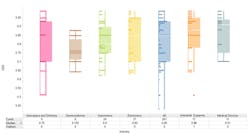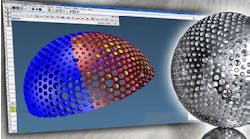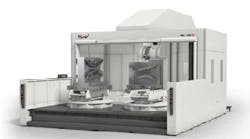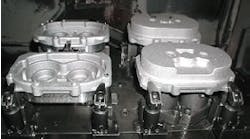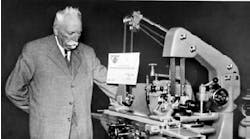Hardinge Inc.; founded 1890 (photos from Iverson and Co.; founded 1931)
Rahn Granite Surface Plate Co.; founded 1943
Miller Electric Mfg., Co. founded 1929
Kurt Manufacturing Co.; founded 1946
Mori Seiki USA Inc.; founded 1948
America's manufacturing might was key to the Allied victory in World War II. By the beginning of 1944, the output of American factories was twice that of all the Axis nations as manufacturers everywhere shut down normal operations and retooled for wartime production. Automakers, for example, produced their last passenger cars on February 10, 1942. They then made aircraft — Chrysler built Martin designs, Ford made planes for Consolidated Aircraft, and General Motors produced aircraft for North American. In addition to airplanes and aircraft parts, the automakers also manufactured trucks, tanks, marine diesels, guns, and shells.
While companies retooled, many of their workers went to war. The women that were left behind picked up the slack, trading their aprons and knitting needles for overalls and hand tools. For the production of B-29 bombers alone, women accounted for one-third of all workers. The aircraft industry, which in 1939, employed less than 47,000 people and produced fewer than 6,000 planes, hit its peak in 1944. That year, the industry employed 2,102,000 workers and rolled out more than 96,000 planes.
Tanks and ships were also produced at record numbers. Medium tank production, in fact, advanced at such a rate that it actually had to be cut back before the war even ended. And shipbuilding also increased to handle merchant shipping, which rose from about one million tons in 1941 to 19 million tons only two years later.
The National Defense Advisory Commission oversaw wartime production, including the manufacture of machine tools. One of AMERICAN MACHINIST's own aided this effort. Mason Britton, former publisher, was responsible for working out a system of priorities for machine tools. According to AMERICAN MACHINIST's history, "Britton quickly discovered that government officials were convinced that the country needed new plants but were generally unaware that, without machine tools, the buildings would be worthless."
Wartime production of lathes, mills, grinders, and other machine tools skyrocketed — peaking in 1942 — once industry realized it needed these machines to make planes, trucks, and tanks. Collectively, more machine tools were manufactured between 1940 and 1943 than had been made between 1900 and 1940.
Many machine tool builders ran full out during the early 1940s. Cincinnati Machine produced 1,000 machine tools in a four-week period, a production record for the company. The Monarch Machine Tool Co. became the first company in the U.S. to run two shifts to meet wartime requirements. And Hardinge utilized its complete facilities for maximum production.
Many other builders also stayed busy. Bridgeport's turret milling machine contributed significantly to WWII efforts, and by 1948, the company had sold its 100,000th machine. R.K. LeBlond Machine Tool Co. produced gun boring lathes for the war effort. And Barnes International's solution to a manufacturing problem became an entirely new metalworking process.
What Barnes did was develop horizontal honing machines that precisely finished the bores of gun barrels for the best rifling operation. The effect of this new finishing method was demonstrated in the tremendous amount of money and time saved in maintaining fighting equipment for the U.S. The Navy, in particular, used these machines to service large-caliber naval guns after they had been fired a certain number of times. These machines were designed so that it was possible to recondition guns in service without removing the gun barrel from the gun emplacement.
Barnes also built the world's largest machine for honing gun barrels and catapult tubes for aircraft carriers. The machine was 190-ft long, weighed 45 tons, and finished barrels up to 30-in. in diameter and 75-ft long.
Another metalworking company that contributed to the war effort was Harig Manufacturing Corp., founded as a tool and die manufacturer in 1937. The company spent the war years filling military orders exclusively and even received a citation by the Armed Services for developing advanced tooling to manufacture the M1 rifle clip.
Materials and other resources were often hard to come by during the war. Just as it had during WWI, Kingsbury once again halted its toy production to turn its attention to machine tools. The materials the toys were fashioned from — heavy gauge steel, flat steel springs, soft rubber, enamel paints, and automotive lacquer — were all needed for the war effort. And since toys were not high on the government's list of requirements, Kingsbury concentrated on making machinery to produce rifle bolts and shell casings.
In the tool and die industry, surface plates were made from steel or cast iron and meticulously scraped flat by skilled craftsmen. However, both steel and cast iron were considered valuable strategic materials, and acquiring a steel surface plate became nearly impossible. One enterprising machinist — his name is now lost to history — contacted a sculptor named Velsey, who worked for a monument company. The machinist asked Velsey if he could supply a "very flat tombstone" for use as a makeshift substitute surface plate. Velsey complied, and soon other machinists and tool and die workers came knocking at his door.
Velsey started the Velsey Granite Surface Plate Co., hiring, among others, Ivan Rahn. Ivan's father, Rudolph, was a mechanical engineer who thought he could improve the process. He noted that the precision measurement references were produced by a sculptor with little engineering knowledge.
In the meantime, Ivan started working with the local monument company that had originally employed Velsey. The company had set up its own surface plate division and named it Herman Stone Co.
While Ivan was working there, he and his father perfected techniques for producing surface granite plates. Their plan was to go into business for themselves, but first they had to practice a bit of subterfuge. When Ivan's coworkers were observing him, he would incorrectly lap a piece, then quickly correct the surface when no one was watching. In 1941, however, Ivan and his father started the Rahn Granite Surface Plate Company.
It's interesting to note that part of the reason that Rudolph wanted to start the business was that Ivan had lost most of his hearing in early childhood. In the 1940s, deafness was often equated with mental deficiency, and career options for the hearing impaired were almost entirely limited to menial labor. Rudolph knew that these perceptions were wrong, and part of the company's early history was to provide a pilot project to demonstrate that hearing-impaired employees were as capable as anyone else of performing skilled labor, and even managing a business. Today, approximately 60% of the Rahn's workforce is hearing impaired.
The U.S. economy prospered after WWII, and veterans had little trouble finding work, partially because the pent-up demand for consumer goods was so high. In the five years after the war, national production increased as did worker income, and industries such as automotive had audiences hungry for new products.
In the machine tool industry, though, times were a bit tougher. The industry that had produced about 800,000 machine tools during the war suddenly found 300,000 surplus machines dumped on the market.
But even with all this surplus, metalworking shops were still interested in seeing new technology. That's why, for the first time since the start of the war, the National Machine Tool Builders' Association hosted a Machine Tool Show. The 1947 Chicago exhibition was held inside an empty Chrysler-Dodge plant that was soon to be occupied by the Tucker Motor Car Co. Among the products introduced was a startling pink synthetic cutting fluid, called Cimcool, made by the Cincinnati Milling Machine Co. Reportedly, this coolant was quite eye-catching in the sea of slate-gray machine tools.
The postwar economy was kind to some builders. Kingsbury, for one, was riding high on the rush of automobile business and shifted all production to the design and manufacture of specialty metalforming machines. However, with its focus now on the machinery business, its other business, toymaking, had to go for good.
Miller Electric, on the other hand, was one of the companies that saw business drop because of oversupply. Fortunately, the successful introduction of a small, hand-held welder kept the company afloat.
Some businesses got a helping hand from lenders that offered small and medium-sized businesses credit for working capital, operating costs, and taxes. Companies like Heller Financial were known for financing "bootstrap buyouts" that let companies owned by families or entrepreneurships borrow against their assets. The company, in fact, financed a number of business ventures. But perhaps its most glamorous dealings were with the film industry, financing such films as "A Walk in the Sun," "The African Queen," "High Noon," and "Never on a Sunday."
The years after World War II did prove to be fertile for startup companies with good ideas and lots of enthusiasm. For example, in 1945, one of the original employees of McKenna Metals Co. (later known as Kennametal) decided to strike out on his own. William E. Newcomer wanted to make and sell his own brazed tools using the "stress-free" brazing method he had developed and to take advantage of the then rapidly growing market opportunities for carbide cutting tools. He founded Newcomer Products, which sold the first "thro-way" tungsten carbide inserts for mechanical toolholders.
Workholding company Kurt Manufacturing began as a machine shop in 1946. Kurt Kuban, a tool and die maker who left Germany in 1923, worked in the ordnance industry for many years. He started his own business when he saw an opportunity to provide high-quality, precision-machined parts to leaders in the ordnance, computer, and aerospace industries.
George Price Grieve grabbed his chance for success in 1949 when he bought a small sheetmetal shop for $1,000, using the army combat pay he saved from four years in the Pacific. He eventually built the business into The Grieve Corp., an oven and furnace manufacturer.
While all this was going on in the U.S., overseas manufacturers were keeping busy. In Japan, Toyoda Machine Works Ltd. was spun off from Toyota Motor Corp. in 1941. The new company was quickly established as an independent machine tool builder serving a number of industries, primarily automotive and munitions.
Miyano Machinery Inc. started from the spark of a cigarette lighter. The popularity of tobacco during the war resulted in heavy consumer demand for cigarette lighters and a lucrative niche for Miyano founder Toshimori Miyano. At the time he founded Miyano File Manufacturing Co., no equipment existed to facilitate the mass production of spark wheels. Miyano soon produced such a machine.
In 1948, the company brought the AL-S25 camoperated automatic lathe to market. Used to improve the production of Miyano's spark wheels, this machine was the first automatic lathe fully designed and produced in Japan.
Also in 1948, Hikoichi Mori established a business for producing textile machinery. His company didn't stay in this business for long, however. By 1958, Mori Seiki discontinued its original product line to focus on the manufacture of high speed, precision manual lathes.
Across the globe, in Sweden, steel manufacturer Sandvik and AB Hammarby-Lampan (Luma) started production of carbide cutting tools in 1942. Luma, which manufactured tungsten for filaments, supplied cemented carbide to Sandvik, which machined the blanks, manufactured cutting tools, and sold the finished product, called Coromant. The company concentrated on manufacturing and selling complete tools, milling cutters,
twist drills, reamers, and scrapers. The range of products was to include tool geometries and cemented carbide grades for machining different materials.
Brazed turning tools quickly became the largest product group, and, to simplify matters for the sales force, turning tools — including sets of five plus a handlap — were sold packed in small wooden boxes. Ture Clason, who later became Coromant's first sales manager, explained how, in the 1940s, he was given a company bicycle and a number of those wooden boxes to go around and show the tools in the Stockholm region. "At the time, I hardly knew what was in the boxes or how the tools should be used," he said.
One small jobshop in Switzerland probably would have been able to tell him. Schneeberger, which specialized in sharpening woodworking tools, decided to expand in 1945. The company, originally founded in 1923, determined that conventional sliding guideway designs were not precise enough for its applications. Therefore, it developed a tool grinding machine with cross roller linear bearings. A few years later, Schneeberger began manufacturing linear bearings to customer specifications.
Yet another Swiss company that started in the 1940s was KPT/Kaiser's parent company, Heinz Kaiser Ltd. Founded by Heinz Kaiser in 1949, the company originally did subcontract machining work. One of its first challenges was the redesign of a Longines watch for the American market.
After the war ended, most European countries were not only rebuilding their cities but also their industry. In Germany for example, Emag's factory buildings were destroyed and the remaining machines confiscated and shipped to Russia. In 1948, with the plant expropriated by the East German state, the company re-formed in West Germany. The new beginning in Ulm-Einsingen proved to be a difficult one. Design drawings were lost, so machines had to be borrowed from customers in the West and disassembled to make detailed component drawings. This proved to be the catalyst for improved machine designs, especially in the area of grinding machines.
The original factory of Rohm, a producer of drill chucks, was also destroyed during the war. In the aftermath, founder Heinrich Rohm and his family were evacuated to Heidenheim, Germany, on the River Brenz. They moved to Sonthim in 1946, where their factory was rebuilt.
After World War II, Heller Germany had to expand outside of Germany due to Allied sanctions on drilling gun barrels. During the war, the company specialized in deep-hole drilling. It put its name on the map when Albert Speer, head of weapons production in Germany, put Werner Kleine in charge of cannon barrel production in Northern Germany. Kleine was instructed to find the most efficient methods of deep-hole drilling.
Kleine discovered two companies making deep-hole drilling tools that used high-pressure coolant to force the chips produced out through the I.D. of the drill tube. One was Beisner and the other was Heller of Schmalkalden, Germany. He determined that Beisner was further ahead in development, but Heller was better at production. Heller's internal exhaust method of drilling was used for the balance of WWII.
At the end of the war, Kleine went to work as managing director of Heller. When the Iron Curtain went up, he smuggled his people and technology to Bremen, Germany.
Years later, in 1956, Kleine and Jack Ladendorf founded American Heller. It was the first company in the U.S. to use the internal chip and coolant exhaust method of drilling that was developed by Heller Germany.
A number of new technologies were introduced in the 1940s. In 1942, for example, the United States' first jet engine, the Bell XP-59 Airacomet, effectively launched America into the jet age. The plane was powered by two GE 1-A turbojet engines.
The decade also saw the first computers. In 1946, the Eniac (Electronic Numerical Integrator and Computer) was developed to calculate ordnance tables for the University of Pennsylvania Ordnance Department. The punchcard-format system filled a room 30 X 50 feet.
Electronics got a boost in 1948 when Bell Telephone Laboratories introduced the transistor, which could perform nearly all the functions of the vacuum tube.
There were other important milestones, but as far as the machine tool industry was concerned, the most important technology of the decade, and arguably the century, was when John T. Parsons painstakingly developed numerical control. In 1948, Parsons built a demonstration mating a milling machine to a punch-card system. His idea was that numerical control (NC) could help produce integrally stiffened skins for aircraft. His efforts were impressive enough to convince the U.S. Air Force, in 1949, to start research projects on NC at the Massachusetts Institute of Technology.
The Air Force subsequently placed large contracts for numerically controlled machines to shape contoured aircraft parts at high speeds. Four companies built the machines: Cincinnati Milling, Giddings & Lewis, Kearney & Trecker, and Morey Machinery. Five companies made the controls: General Electric, Giddings & Lewis, Cincinnati Milling, Bendix Aviation, and Electronic Control Systems Inc.
Parsons' idea would totally re-shape the metalworking industry in the years to come.
1940John T. Parsons Parsons Corp. John T. Parsons' work and engineering experience brought about one of the most revolutionary changes the metalworking industry has ever seen. Parsons Corp. made many products to help in the WWII effort, including helicopter rotor blades. In 1947, Parsons developed a method allowing milling machine operators to produce airfoil templates to check blades using a chart of table and cutter settings prepared on IBM punchcard machines. Within two years of that initial innovation, Parsons was working on a punchcard system that totally controlled a milling machine — the first numerically controlled machine, which made wing panels for a Lockheed bomber. He returned to his masterful invention in 1969 and ended up changing the auto industry. He adapted NC to make polystyrene foundry patterns for cast metal machine tool bases, and soon after, automakers were using the process to cast body dies for cars. |
Companies founded in the 1940sJ&S Tool Co. Inc. (1941), Toyoda Machinery USA (1941), AB Sandvik Coromant (1942), Miyano Machinery Inc. (1943), Rahn Granite Surface Plate Co. (1943), Newcomer Products Inc. (1945), Optical Gaging Products Inc. (1945), Bristol Tool Co. (1946), Kurt Mfg. Co. (1946), Naltex (1946) KPT/Kaiser Precision Tooling Inc. (1948), Mori Seiki USA Inc. (1948), The Grieve Corp. (1949) |
